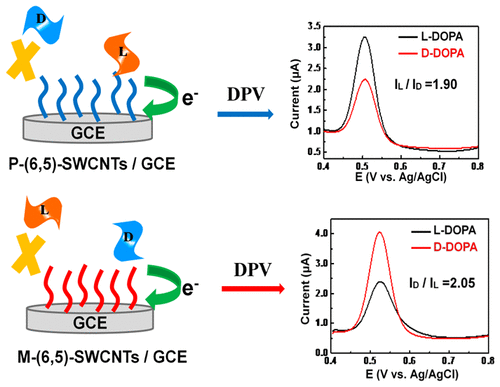当前位置:
X-MOL 学术
›
Anal. Chem.
›
论文详情
Our official English website, www.x-mol.net, welcomes your
feedback! (Note: you will need to create a separate account there.)
Enantiomers of Single Chirality Nanotube as Chiral Recognition Interface for Enhanced Electrochemical Chiral Analysis
Analytical Chemistry ( IF 6.7 ) Pub Date : 2019-01-15 00:00:00 , DOI: 10.1021/acs.analchem.8b05336 Chunling Pu 1 , Yunxia Xu 1 , Qi Liu 1 , Anwei Zhu 1 , Guoyue Shi 1
Analytical Chemistry ( IF 6.7 ) Pub Date : 2019-01-15 00:00:00 , DOI: 10.1021/acs.analchem.8b05336 Chunling Pu 1 , Yunxia Xu 1 , Qi Liu 1 , Anwei Zhu 1 , Guoyue Shi 1
Affiliation

|
Although separation of single-walled carbon nanotubes (SWCNTs) according to their helicity and handedness has been attracting tremendous interest recently, exploration of the left- and right-handed SWCNT enantiomers (defined as “M” and “P”) to chiral sensing still remains in the early stage. Here we presented a new electrochemical sensor for chiral discrimination, which for the first time amplified the chiral selection on the electrode surface based on the left- or right-handed semiconducting SWCNT enantiomers with (6,5)-enriched chirality. The enantioselectivity was demonstrated by different peak current response to analyte enantiomers, observed in differential pulse voltammogram (DPV). Chiral distinguishing might be a result of the formation of an efficient chiral nanospace originating from the high purity of single enantiomer of (6,5) SWCNT. The obtained chiral electrodes were also applied to determine the enantiomeric excess (ee) of DOPA. There was a good linear relationship between DPV peak currents and % ee of l-DOPA. This study is the first example showing how the structure of chiral SWCNTs influences electrochemical chiral recognition.
中文翻译:

单一手性纳米管的对映体作为手性识别界面,用于增强电化学手性分析
尽管最近根据单螺旋碳纳米管的螺旋度和惯用性来分离单壁碳纳米管(SWCNT)引起了极大的兴趣,但仍在探索用于手性传感的左旋和右旋SWCNT对映异构体(定义为“ M”和“ P”)仍处于早期阶段。在这里,我们提出了一种用于手性识别的新型电化学传感器,该传感器首次基于具有(6,5)富集手性的左手或右手半导体SWCNT对映体,放大了电极表面上的手性选择。对映选择性是通过在差分脉冲伏安图(DPV)中观察到的对分析物对映体的不同峰值电流响应来证明的。手性区别可能是有效手性纳米空间形成的结果,该空间源自(6,5)SWCNT的单个对映异构体的高纯度。还使用获得的手性电极确定DOPA的对映体过量(ee)。DPV峰值电流与%ee的线性关系良好l -DOPA。这项研究是显示手性SWCNTs结构如何影响电化学手性识别的第一个例子。
更新日期:2019-01-15
中文翻译:

单一手性纳米管的对映体作为手性识别界面,用于增强电化学手性分析
尽管最近根据单螺旋碳纳米管的螺旋度和惯用性来分离单壁碳纳米管(SWCNT)引起了极大的兴趣,但仍在探索用于手性传感的左旋和右旋SWCNT对映异构体(定义为“ M”和“ P”)仍处于早期阶段。在这里,我们提出了一种用于手性识别的新型电化学传感器,该传感器首次基于具有(6,5)富集手性的左手或右手半导体SWCNT对映体,放大了电极表面上的手性选择。对映选择性是通过在差分脉冲伏安图(DPV)中观察到的对分析物对映体的不同峰值电流响应来证明的。手性区别可能是有效手性纳米空间形成的结果,该空间源自(6,5)SWCNT的单个对映异构体的高纯度。还使用获得的手性电极确定DOPA的对映体过量(ee)。DPV峰值电流与%ee的线性关系良好l -DOPA。这项研究是显示手性SWCNTs结构如何影响电化学手性识别的第一个例子。













































 京公网安备 11010802027423号
京公网安备 11010802027423号